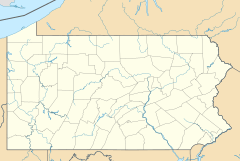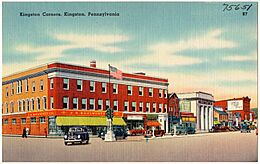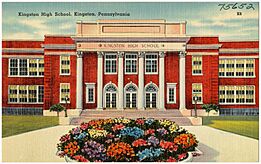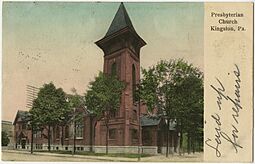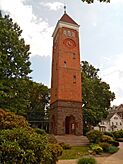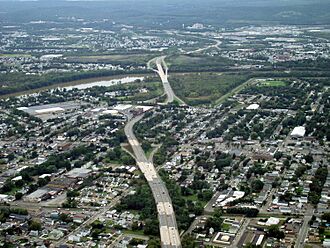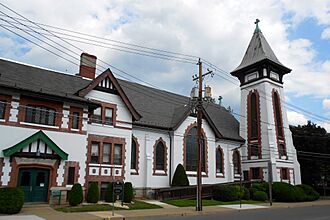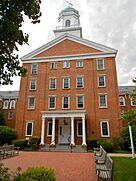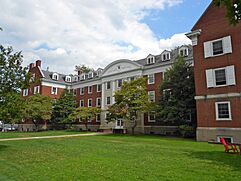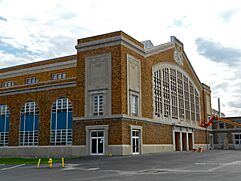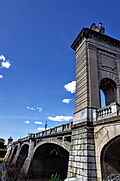Kingston, Pennsylvania facts for kids
Quick facts for kids
Kingston, Pennsylvania
|
|
|---|---|
|
Borough
|
|
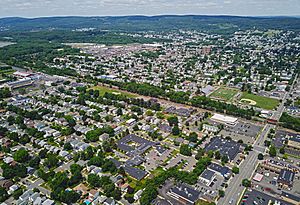
Aerial view of Kingston
|
|
| Motto(s):
"A Great Place to Call Home"
|
|
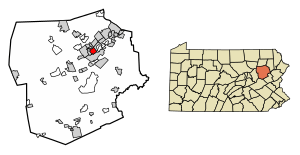
Location of Kingston in Luzerne County, Pennsylvania.
|
|
| Country | United States |
| State | Pennsylvania |
| County | Luzerne |
| Settled | 1771 |
| Incorporated | 1857 |
| Government | |
| • Type | Home rule (strong executive/appointed manager) |
| Area | |
| • Total | 2.21 sq mi (5.71 km2) |
| • Land | 2.15 sq mi (5.56 km2) |
| • Water | 0.06 sq mi (0.16 km2) |
| Elevation | 545 ft (166 m) |
| Population
(2020)
|
|
| • Total | 13,349 |
| • Density | 6,220.41/sq mi (2,401.29/km2) |
| Time zone | UTC-5 (Eastern (EST)) |
| • Summer (DST) | UTC-4 (EDT) |
| Zip Code |
18704
|
| Area code(s) | 570 |
| FIPS code | 42-39784 |
Kingston is a town, also called a borough, in Luzerne County, Pennsylvania, United States. It sits on the western side of the Susquehanna River, right across from Wilkes-Barre. Kingston was first settled in the early 1770s. It officially became a borough in 1857. In 2020, about 13,349 people lived there, making it the biggest borough in Luzerne County.
Contents
History of Kingston
How Kingston Began
In the 1660s, King Charles II owed money to Admiral Sir William Penn. To pay him back, the King gave Penn's son, William, a large area in North America. This land later became Pennsylvania. However, another colony, Connecticut, also said they owned part of this land.
In 1742, Count Zinzendorf visited the Wyoming Valley. He wanted to teach Native Americans about Christianity. At that time, tribes like the Susquehannock and Delaware lived in the valley.
His visit led a group from Connecticut to form the Connecticut Susquehanna Company. This company bought land from the native tribes. In 1768, they met and decided to divide the land into five townships, each five square miles. The first 40 settlers claimed Kingston Township.
By the late 1760s, settlers from both Connecticut and Pennsylvania fought over this land. The dispute ended in the 1780s when the land was given to Pennsylvania. Kingston became part of Northumberland County. However, the Connecticut settlers still wanted to create a new state in northeastern Pennsylvania. Timothy Pickering was sent to check out the situation. This led to the Pennsylvania Assembly creating Luzerne County from part of Northumberland County. This stopped the idea of a new state. Pickering helped set up elections, courts, and a government for the new county.
Kingston During the Revolutionary War
On June 30, 1778, Loyalist soldiers, led by Major John Butler, came to the Wyoming Valley. They planned to attack American settlements. On July 1, Fort Wintermoot gave up without a fight. The next morning, Fort Jenkins also surrendered. Both forts were later burned.
Meanwhile, American soldiers, called Patriots, gathered at Forty Fort. On July 3, about 375 men marched from the fort. They were led by Lieutenant Colonel Zebulon Butler and Colonel Nathan Denison. Major Butler's Rangers, along with about 500 Native American allies, attacked the Americans. Nearly 300 Patriot soldiers were killed in the Battle of Wyoming, also known as the Wyoming Massacre.
The next day, Colonel Denison surrendered Forty Fort and other posts. After this, buildings were looted and burned across the Wyoming Valley. Most people living there fled across the Pocono Mountains to towns like Stroudsburg and Easton. Others went down the Susquehanna River to Sunbury.
Kingston Becomes a Borough
Kingston has a strong history in education. It is believed that Pennsylvania's first public school was built in Kingston in the 1770s. The town is also home to Wyoming Seminary, a well-known college preparatory school started in 1844. In its first year, it had 31 students. Today, Wyoming Seminary's campus teaches about 450 students.
Kingston grew quickly after the Lackawanna and Bloomsburg Railroad was built. It officially became a borough on November 23, 1857. The borough was named after Kingston, Rhode Island. The first election was held on December 15, 1857. Ruben Jones was elected as the first burgess, like a mayor.
In 1923, the Kingston Armory was built. On September 11, 1950, 33 soldiers from the 109th Field Artillery Regiment died in a train accident in Ohio. Their bodies were brought to the Kingston Armory for their families.
Coal mining was a major industry in Kingston until the Knox Mine Disaster in 1959. This tragedy largely ended coal mining in the area. In June 1972, Kingston was badly damaged by flooding from Hurricane Agnes. The hurricane caused a state of emergency in Kingston and nearby Wilkes-Barre. President Richard Nixon visited the area. He asked Frank Carlucci, a Wyoming Seminary graduate, to help with flood recovery. After the flood, Kingston adopted a home rule charter, which means it gained more control over its own government. This became effective in January 1976.
Geography and Location
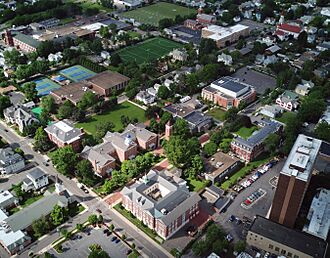
Kingston is located in the Wyoming Valley in Northeastern Pennsylvania. It is on the western side of the Susquehanna River in the northern part of Luzerne County.
The U.S. Census Bureau says Kingston covers about 5.7 square kilometers (2.2 square miles). Most of this area is land, with a small part being water. The Susquehanna River and Kirby Park separate Kingston from Wilkes-Barre. Major roads like U.S. Route 11 and Pennsylvania Route 309 (the Cross Valley Expressway) pass through Kingston. Market Street and Pierce Street connect Kingston to Wilkes-Barre with bridges.
Kingston is next to towns like Edwardsville, Pringle, Luzerne, and Forty Fort. The borough is served by the Wilkes-Barre Wyoming Valley Airport and the Wilkes-Barre/Scranton International Airport.
Kingston's Climate
Kingston has a humid continental climate, meaning it has four clear seasons. Winters are cold, with an average January temperature of about -3.4°C (25.8°F). The surrounding mountains affect the weather, causing temperatures to vary. Temperatures below -17.8°C (0°F) are rare, happening about three days a year. The average yearly snowfall is about 117 centimeters (46.2 inches). Heavy snowstorms are uncommon, but when they happen, they can disrupt daily life.
Summers are warm, with an average July temperature of about 21.9°C (71.4°F). Temperatures above 32.2°C (90°F) happen about nine days a year and can sometimes go over 37.8°C (100°F). Spring and fall weather can change a lot, but they are usually mild. Kingston gets about 97 centimeters (38.2 inches) of rain each year, spread fairly evenly, though summer months get more. The lowest temperature ever recorded was -29.4°C (-21°F) in January 1994. The highest was 39.4°C (103°F) in July 1936.
| Climate data for Wilkes-Barre/Scranton Int'l Airport, Pennsylvania (1981–2010 normals, extremes 1901–present ) | |||||||||||||
|---|---|---|---|---|---|---|---|---|---|---|---|---|---|
| Month | Jan | Feb | Mar | Apr | May | Jun | Jul | Aug | Sep | Oct | Nov | Dec | Year |
| Record high °F (°C) | 69 (21) |
76 (24) |
85 (29) |
93 (34) |
93 (34) |
99 (37) |
103 (39) |
102 (39) |
100 (38) |
91 (33) |
81 (27) |
71 (22) |
103 (39) |
| Mean maximum °F (°C) | 55.4 (13.0) |
56.4 (13.6) |
69.6 (20.9) |
81.3 (27.4) |
86.6 (30.3) |
89.8 (32.1) |
91.8 (33.2) |
90.0 (32.2) |
85.7 (29.8) |
77.3 (25.2) |
68.7 (20.4) |
57.5 (14.2) |
93.4 (34.1) |
| Mean daily maximum °F (°C) | 33.2 (0.7) |
36.8 (2.7) |
46.2 (7.9) |
59.1 (15.1) |
69.7 (20.9) |
77.7 (25.4) |
81.9 (27.7) |
79.9 (26.6) |
72.3 (22.4) |
60.7 (15.9) |
49.4 (9.7) |
37.5 (3.1) |
58.8 (14.9) |
| Mean daily minimum °F (°C) | 18.5 (−7.5) |
20.7 (−6.3) |
27.6 (−2.4) |
38.2 (3.4) |
47.6 (8.7) |
56.5 (13.6) |
60.9 (16.1) |
59.5 (15.3) |
52.1 (11.2) |
41.1 (5.1) |
33.3 (0.7) |
23.8 (−4.6) |
40.1 (4.5) |
| Mean minimum °F (°C) | −0.8 (−18.2) |
3.2 (−16.0) |
9.1 (−12.7) |
24.0 (−4.4) |
34.4 (1.3) |
43.1 (6.2) |
49.4 (9.7) |
47.1 (8.4) |
37.5 (3.1) |
28.3 (−2.1) |
18.9 (−7.3) |
5.9 (−14.5) |
−3.1 (−19.5) |
| Record low °F (°C) | −21 (−29) |
−19 (−28) |
−4 (−20) |
8 (−13) |
27 (−3) |
34 (1) |
43 (6) |
38 (3) |
29 (−2) |
19 (−7) |
6 (−14) |
−13 (−25) |
−21 (−29) |
| Average precipitation inches (mm) | 2.37 (60) |
2.03 (52) |
2.55 (65) |
3.33 (85) |
3.52 (89) |
4.03 (102) |
3.79 (96) |
3.41 (87) |
4.07 (103) |
3.34 (85) |
3.14 (80) |
2.68 (68) |
38.26 (972) |
| Average snowfall inches (cm) | 14.2 (36) |
9.3 (24) |
9.0 (23) |
3.3 (8.4) |
0 (0) |
0 (0) |
0 (0) |
0 (0) |
0 (0) |
0.1 (0.25) |
2.9 (7.4) |
7.4 (19) |
46.2 (117) |
| Average precipitation days (≥ 0.01 in) | 12.0 | 11.0 | 11.8 | 12.3 | 13.2 | 12.8 | 11.2 | 11.3 | 10.2 | 10.7 | 11.2 | 11.5 | 139.2 |
| Average snowy days (≥ 0.1 in) | 9.3 | 7.7 | 5.0 | 1.7 | 0 | 0 | 0 | 0 | 0 | 0.1 | 2.1 | 7.1 | 33.0 |
| Average relative humidity (%) | 70.1 | 67.5 | 63.3 | 60.4 | 64.6 | 70.5 | 71.1 | 73.8 | 75.2 | 71.6 | 71.8 | 72.5 | 69.4 |
| Mean monthly sunshine hours | 130.3 | 143.7 | 185.7 | 210.5 | 246.9 | 269.7 | 285.7 | 257.2 | 200.2 | 173.3 | 104.3 | 95.9 | 2,303.4 |
| Percent possible sunshine | 44 | 48 | 50 | 53 | 55 | 60 | 62 | 60 | 54 | 50 | 35 | 33 | 52 |
| Source: NOAA (relative humidity 1964–1990, sun 1961–1990) | |||||||||||||
People and Population
| Historical population | |||
|---|---|---|---|
| Census | Pop. | %± | |
| 1860 | 638 | — | |
| 1870 | 1,143 | 79.2% | |
| 1880 | 1,418 | 24.1% | |
| 1890 | 2,381 | 67.9% | |
| 1900 | 3,846 | 61.5% | |
| 1910 | 6,449 | 67.7% | |
| 1920 | 8,952 | 38.8% | |
| 1930 | 21,600 | 141.3% | |
| 1940 | 20,679 | −4.3% | |
| 1950 | 21,096 | 2.0% | |
| 1960 | 20,261 | −4.0% | |
| 1970 | 18,325 | −9.6% | |
| 1980 | 15,681 | −14.4% | |
| 1990 | 14,507 | −7.5% | |
| 2000 | 13,855 | −4.5% | |
| 2010 | 13,182 | −4.9% | |
| 2020 | 13,349 | 1.3% | |
In 2000, there were 13,855 people living in Kingston. There were 6,065 households and 3,372 families. The population density was about 2,495 people per square kilometer (6,461.6 per square mile).
Most people in Kingston are White (96.84%). There are also African American (0.77%), Asian (1.53%), and other groups. About 0.80% of the population was Hispanic or Latino.
About 23.1% of households had children under 18. The average household had 2.16 people, and the average family had 2.94 people.
The median age in the borough was 43 years old. About 19.7% of the population was under 18, and 24.4% was 65 or older.
The median income for a household was $33,611. For families, it was $45,578. About 11.3% of the population lived below the poverty line.
Religion in Kingston
About 59.27% of people in Kingston consider themselves religious. Most are Catholic (43.77%). Other Christian faiths make up 2.33%, and 0.78% are Jewish.
Culture and Fun Facts
Kingston in Movies and TV
- In 2013, the movie The English Teacher was set in Kingston. It mentions places in the Wyoming Valley, like Wilkes University.
- In 1976, an episode of the Israeli TV show Gabby & Debby took place in a Kingston coal mine. In the episode, two young people rescue a worker trapped after an accident.
Historic Places to Visit
Several places in Kingston are listed on the National Register of Historic Places. This means they are important historical sites. These include Fleck Hall at Wyoming Seminary, the Kingston Armory, and the Market Street Bridge.
Famous People From Kingston
- Edie Adams (1927–2008), a singer, actress, and comedian.
- Mike Aquilina (born 1963), a popular author.
- Michael Barone (born 1946), host of the organ music radio show Pipedreams.
- George Bednar (1942–2007), a college football player.
- Kevin Blaum (born 1952), a Pennsylvania State Representative.
- Charles Bressler, an opera singer.
- Russell Bufalino (1903–1994), an organized crime leader.
- Francis Dolan Collins (1841–1891), a U.S. Representative.
- Bob Coolbaugh (1939–1985), an American football player.
- Clarence Dennis Coughlin (1883–1946), a U.S. Representative.
- Craig Czury (born 1951), an American poet.
- George Denison (1790–1831), a U.S. Representative.
- Steamer Flanagan (1881–1947), a Major League Baseball player.
- Dan Harris (born 1979), a Hollywood director and screenwriter.
- Jimy Hettes (born 1987), a mixed martial artist.
- Henry M. Hoyt (1830–1892), a Governor of Pennsylvania.
- Stephanie Jallen (born 1996), a Paralympic skier.
- Aaron Kaufer (born 1988), a Pennsylvania State Representative.
- Bill Kern (1906–1985), an American football player and coach.
- Phyllis Mundy (born 1948), a Pennsylvania State Representative.
- Paul F. Nichols (born 1952), a delegate to the Virginia General Assembly.
- Dennis Packard (born 1982), a professional ice hockey player.
- Tina Pickett (born 1943), a Pennsylvania State Representative.
- Joe Pisarcik (born 1952), an American football quarterback.
- Suzie Plakson (born 1958), an actress.
- Dave Popson (born 1964), a National Basketball Association player.
- Lauren Powley (born 1984), an American field hockey player.
- John Quackenbush (born 1962), a computational biologist and genetic researcher.
- Edwin Raub (1921–1998), a television personality.
- Ed Rutkowski (born 1941), an American football player.
- Lazarus Denison Shoemaker (1819–1893), a U.S. Representative.
- Len Supulski (1920–1943), an American football player.
- Dan Terry (1924–2011), a trumpet player and big band leader.
- Charles Murray Turpin (1878–1946), a U.S. Representative.
- Frank Zane (born 1942), a bodybuilder and three-time Mr. Olympia.
- Ned Russin (born 1990), lead singer and bassist for Title Fight.
See also
 In Spanish: Kingston (Pensilvania) para niños
In Spanish: Kingston (Pensilvania) para niños


